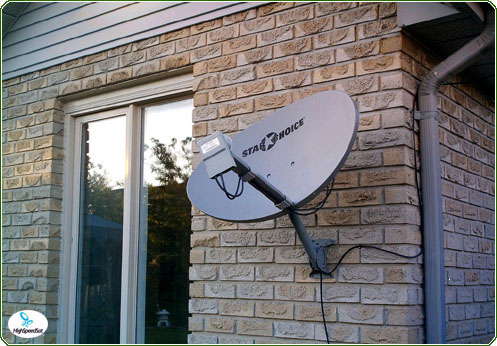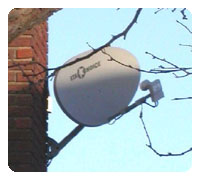Satellite TV Star Choice

Star Choice Canada Satellite TV offers over 430 channels, up to 21 HD channels at no extra cost. A full range of programming packages for English, Bilingual and French Programming. ![]()
Star Choice is currently Canada's second largest direct to home satellite service. It was incorporated in 1996 as Star Choice Television Network, a subsidiary of Direct Choice, a small distributor of satellite components in Eastern Canada. Two competing companies, Expressvu Inc. and Power Directv Inc. had been licensed a year previous by the CRTC, but had not been successful in actually bringing an operational service to the Canadian market. Star Choice had recognized the immediate need for a Canadian service, as tens of thousands of Canadians were opting to purchase a grey market satellite system for the U.S. Directv and Dish Network services.
The company was based in New Brunswick, Canada and had ambitious plans for the Canadian market. What they lacked in size and corporate strength, they made up in spades with spirit as they would be competing head to head with Expressvu Inc., which was wholly owned by BCE, Canada's largest Telecommunication Company, a company with hundreds of millions in cash reserves.
Clearly Canada was in desperate need of a digital satellite service as most Canadians were tired of unfulfilled promises, as Expressvu had committed over half a dozen launch milestones which they had missed for a number of reasons from equipment problems to satellite capacity. For many Canadians, the grey market had become the only alternative, especially to those in rural areas which were not services by cable vision.
A Canadian DTH satellite license had been applied for in early 1996, which was finally granted by the CRTC at the end of August 1996. It had an initial projected launch milestone of last quarter of 1996. In March of 1996, the troubled Canadian Anik E1 satellite suffered a near total loss of its satellite capacity as one of its primary power systems had failed, leaving it crippled. This loss meant that there was no longer sufficient satellite capacity to allow 2 fully operational satellite services. One of the CRTC's primary conditions of license was that Canadian satellites must be used to deliver Canadian signals. It would allow US signals to be delivered via US satellites however.
Star Choice's initial platform was to utilize the Canadian Anik E1 satellite to deliver 112 channels, which would include 52 Canadian and US video channels as well as 35 digital audio channels. They had also planned to offer an additional 25 U.S. CRTC approved channels from the Dish Network satellites, which at the time was seen as ambitious as no DBS provider had provided equipment that would receive feeds from 2 seperate satellites on one small dish. They had entered into an agreement with Echostar, the parent company of the U.S. Dish Network satellite service to provide equipment for the Canadian DBS venture.
The loss in capacity meant Starchoice would have to modify its initial programming offerings and push back its launch date. In early 1997, Star Choice and HomeStar, a wholly owned subsidiary of Shaw Communications began negotiations for a possible merger. HomeStar had recently received authorization from the CRTC to begin a DTH service in Canada, but had not yet put the infrastructure in place. A merger with meant they would be set for a much earlier entrance in the Canadian market. It also meant for a much needed source of financial backing from Shaw, which was one of Canada's largest cable vision companies. The merger was put before the CRTC and approved in May of 1997. It gave Shaw controlling interest in Star Choice. Show also had controlling interest in Cancom, which owned much need satellite capacity aboard the Anik E2 satellite. This gave Star Choice the capacity it needs to launch a full featured DTH service to the Canadian market. Shaw also made some equipment changes, abandoning the Echostar platform in favor of the Motorola Digicipher II platform, in use in the US by Primestar. Motorola is a recognized leader in consumer electronics.
In late May, 1997, the Star Choice service went on the air and was officially launched. Ironically, it was one of the last companies in Canada to be awarded a license by the CRTC to commence a Canadian satellite broadcasting operation , yet it became the first company to actually fully launch a successful service, beat only by the Alphastar Canada service, which would fail some months later. Expressvu would also launch their service to Canadian in late summer of 1997, more than 2 1/2 years after they had been licensed. Initially, both Canadian services shared satellite capacity on the Anik E2 satellite. Expressvu would however move to a new DBS satellite, Nimiq 1 launched by Telesat in 1999. This would free up a large capacity for Star Choice to expand their service to better compete with Expressvu, which controlled nearly all of of the capacity on Nimiq 1. Star Choice was also able to aquire some capacity aboard the crippled Anik E1 satellite, which was scheduled for replacement in 2004 by a new Anik F2 satellite. Anik E2 was replaced by the successful launch of Anik F1 in 2000 at the Telesat 107.3° WL orbital location. This offered more broadcasting power at 115 watts per channel, more capacity with 48 active and 10 space Ku channels as well as 44 C band channels as well as a larger satellite footprint, covering virtually all of North America. The crippled Anik E1 satellite was also replaced by the new Anik F2 satellite at Telesat's 111.1° W.L. orbital location, launched in July 2004. Two new Canadian satellites are also scheduled for launch in 2005/2006. Anik F1-R is scheduled to be launched in late 2005, replacing the Anik F1 satellite and allowing for an in-orbit spare. Anik F3 is also scheduled for launch in second quarter 2006 at a new Telesat 118.7° orbital location, offering an additional 32 Ku, 2 Ka and 24 C-Band transponders. It is expected that the launch of this new satellite will free up some additional capacity on Anik F1 and F2, which could be used to expand their high definition lineups
 Anik F1 satellite Footprint 107.3° W.L.
Anik F1 satellite Footprint 107.3° W.L.

Anik F2 satellite Footprint 111.1° W.L
Today, Star Choice offers up to 350 Canadian and U.S. video and audio channels to its more than 850 000 subscribers from two of Canada's most powerful commercial satellites, Anik F1 and F2 located in geo-synchronous orbit 22 300 miles above the Earth. The broadcast satellites are Anik F1 located at the 107.3 degree W.L. orbital location and Anik F2 located at 111.1 degrees W.L. The satellites are owned and controlled by Telesat Canada.
Home satellite technology brings programming choice directly to your home. Here’s how it works. Star Choice has a number of transmitters across the country. Old-fashioned cables or high tech satellite dishes at these sites collect signals from TV stations across North America. We compress all the signals into a digital feed, then transmit it to our two satellites. The satellites, Anik F1 and Anik E2 are in a stationary orbit 23,000 miles above the earth. Anik F1, which is newer and larger, carries the bulk of the English-language programming. Anik E2 carries mostly French and ethnic programming. Once the satellites receive the signal, it is switched to a different frequency and sent back to earth. That signal is picked up by the satellite dish on your house or apartment and sent to your TV. All you do is turn your TV on. Quality pictures and sound Why digital? Digital technology compresses the signal. We can send more information without slowing things down. The result? You get a cleaner, clearer picture with the best-quality sound. The dish catches the signal. The “eye” at the end of the arm absorbs the signal and does two things to it. First, the signal frequency is changed to work with your receiver. Then, the signal is amplified. It needs a boost after its long journey. A cable takes the signal from your roof or balcony to a receiver inside. It’s an electronic box about the size of a VCR. The receiver unscrambles the signal and sends it to your TV set. It’s the link between the digital signal and your old analog TV set. It all happens faster than you can switch channels. You see the latest movies, sports and news with crystal-clear pictures and vibrant sound. Hooking it all in Our Navigo 305 and 405 receivers, made by Motorola, become the hub of your entertainment system. They can send programming information to your stereo, VCR and television. How you hook up your system depends on what kind of equipment you have. Your Star Choice receiver gives you a choice. It’s built to send information to your TV three different ways, by S-Video, RCA or co-ax cables. S-Video, the newest technology, means a crisper, clearer picture than with older RCA cable technology or co-ax cable. Your Star Choice receiver decodes one channel at a time. You can easily tape programs while you are out. But, you can’t watch one channel and tape another with your VCR. Multiple TVs The ideal way to set up your house it is get a receiver for every TV in your home. You can get the home-theatre quality 405 receiver for your serious TV viewing. The entry-level 305 receiver is great in the kitchen or bedroom. You can buy additional receivers at a retailer, online in the Store and by phone from a friendly customer service representative at 1 888 554-STAR. We charge a $4.99 per month multi-receiver fee if you have two or more receivers. One fee covers every receiver. But, if you subscribe to certain English, French or Bilingual packages, the multi-receiver fee is waived. Even in apartments Many Canadians live in apartments and condos. You can get Star Choice in these buildings and enjoy great programming. There are buildings across Canada already hooked up for Star Choice. They have a dish on the roof with wires taking the programming to each suite. Put your address into our building directory to see if your building is there. If not, you can learn about getting apartment access by contacting us. If you receive permission from your landlord, and you have south exposure, you may be able to have a dish installed on your balcony. Or, with permission, we can install a dish on the building’s roof. Call or contact us about apartments or condos Businesses too! When you’re lying in a dentist chair with your jaw wedged open, it’s nice to have choice. Of TV programs, that is. That’s why many offices and businesses have hooked up with Star Choice. It gives your customers, patients and clients interesting TV to watch in waiting rooms or boardrooms. It also gives you access to 50 digital music channels. They play great commercial-free music 24 hours a day. Imagine real music, like jazz, classics or rock, in the elevator, not elevator music.More Starchoice Satellite Television related links:
ViaSat Frequently Asked Questions - Check the usal questions asked about ViaSatViasat Products - Phones, handhelds, docks, internet data sets and accessories.
How ViaSate satellite Internet system works? - All details about ViaSat system.
Iridium satellites - Iridium communcations satellites, constellation, flares and more!
Vasat Internet Services - Satellite Internet service plans, activation
Satellite Internet Blog - Comment the latest info from satellite Internet arena
Internt over Satellite Forum - Raise a topic with other sat-Internet enthusiasts about products, installations or applications.
